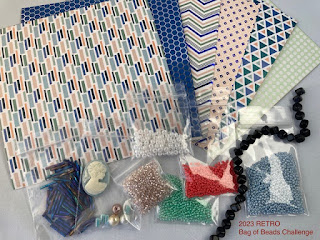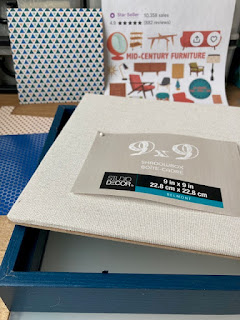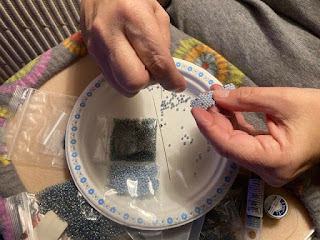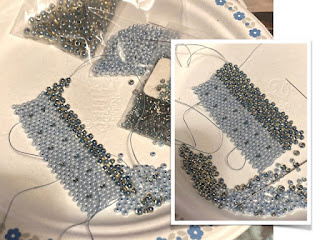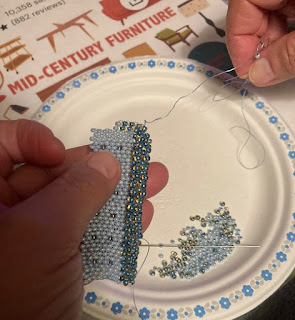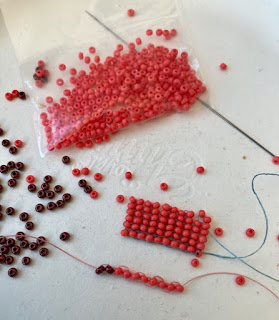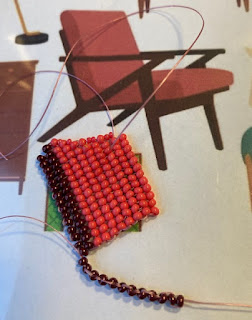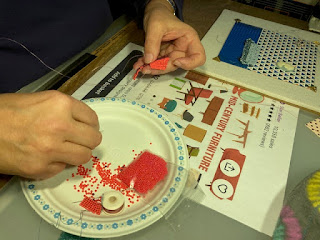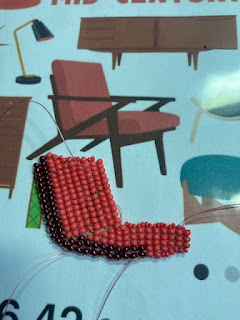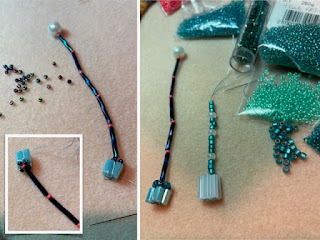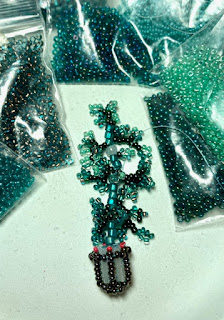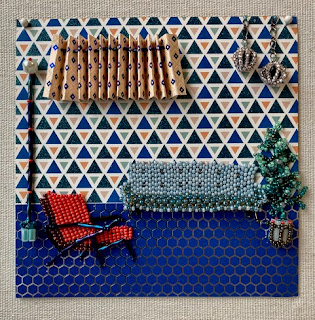Something very different for this year’s Toronto Bead Society (TBS) Challenge! The hardest part was getting an idea, a theme, once we saw the contents of Bag of Beads.
The craft papers with distinct Retro patterns were the stumper this year! Can’t wait to see what the other bead society members come up with at the February REVEAL!
Since my condo suite was getting all windows and doors replaced in mid-December, I was in tune with furniture, moving, and shlepping everything 6 feet away from the window wall. Once the new windows were installed, we had a chance to redecorate. At first, my idea was WINDOWS, but with three distinct craft paper patterns in my bag, furnishing a room in the mid-century style made perfect sense.
To make Mid-Century Modern Living happen, I needed a reference of furniture styles so I could beadweave a sofa and chair with beads in the bag. Thanks to an Etsy seller for their clip art of mid-century furniture for inspiration.
This stitch is easy when you can see the high points and know where to add the next bead row. I created a tufted back effect by adding single copper-lined turquoise seed bead every three beads. First, I started with Even-count Peyote with an easy turn, but my tuft button design forced an Odd-Count variation.
To create a 3-D cushion for my sofa, I added a row of 6/o blue-lined topaz pony beads to the last row of light blue seed beads.
From here I was able to Right Angle Weave (R.A.W.) rows of pony beads. First, I tested the idea, then I beadwove the appropriate number of rows of pony beads for the sofa cushion.
Next, I had to zip together the pony beads into a cushion. This was done by folding over the flat pony bead fabric and carefully continuing the R.A.W. stitch to make it 3-dimensional.
A final addition of single light blue seeds between the bottom of the front cushion help turn this mass of beadweaving into a Mid-Century Modern sofa. I added #2 brown Iris bugle feet like the sofa illustration.
When creating flat 3-dimensional objects, you need to add other colored-beads to represent the contours in the illustrated chair. So, the flat Ndebele stitched coral piece would not work in my Mid-Century living room.
Once satisfied with the chair back, I started a ladder for the seat cushion. This took many tries to create a visually pleasing seat. I’m just showing the process and final variation.
Creating an independent chair took a lot of effort. Here I am at my clean beading room table after the window replacement!
This Ndebele stitched cushion had many looks. This is last variation. I was constantly referring to the illustration for how to handle the chair arms once the cushion was ready.
To shape the cushions, I added very fine 15/o seed beads to smooth out the choppy edge created by the Ndebele stitch.
Long twisted navy iris bugle were going to be the arms and frame of my occasional chair. However, because of the length, I had to supplement #2 and #3 twisted bugles from my stash to get the appropriate lengths and effects. The front arm of the chair was first cobbled together over the top of the beadwoven cushion.
For my chair to be realistic, I needed to add the other arm from behind, as well as chair legs. Note how just placing a long bugle across the lower seat bottom creates a realistic looking chair. It’s all about perspective and illusions.
Since I was going to use the coralling twig technique to create the foliage, I strung a core of 8/o beads between white pearl 6/o pony beads which were going to be hidden under plant leaves. I strung metallic dark teal 10/o seed beads as branches from which I would create leaves. Each leaf has a random assortment of five shades and finishes of teal and green seed beads. The light green seeds from The Bag were generally placed at the tips of the leaves which were created as a loop was formed when the needle was inserted through the dark metallic string in random places.
Coralling is best done in hand because firm tension is important. The leaves should stick out all over and overlap when branches cascade.
The curtains took a bit of playing around with length and finger folding. I took advantage of the repeat of the fine diamond print for establishing the depth of the pleats. The fine line around the diamond helped keep the stitches uniform with a small #1 bugle inserted between pleats.
Stitching down the potted plant was pretty easy. I could position the foliage as needed; cover the pearl beads in the core; pull thread tighter so leaves stand out. I even added in a few light green beads near the bottom for sparkle.
The torchiere was also easy to stitch down thanks to the graphic pattern on the paper. I tacked between the coral seed beads so the bugles lay nice and flat. Once this was in place, it was time to carefully position the occasional chair. Note, it was finally placed much lower, closer to the front to create a comfy layout. Careful stitching of the chair cushions and tacking the bugle arms and chair legs were relatively easy.
To stitch down the curtains, it was necessary to tack between the pleats near the top. I also tacked near both lower ends so the curtains ‘hang straight’.
The chain links of the globe lights were stitched along to top right. One globe was hung lower than the other for balance. Note how taut the torch light is in this side view. Everything is securely stitched.
I pinned my Mid-Century Modern Living scene to the linen background with the white pins provided with the shadow box.
The glass of the shadow box will protect my beadwoven furniture and decor, but it’s impossible to photograph without glass reflections.
This Bag of Bead Challenge was fun once I got the idea. I enjoyed looking at different furniture images and figuring out how can I best beadweave them as stand alone pieces. It helped having knowledge of a host of stitching techniques and combining them as needed for the desired 3-dimensional furniture.
